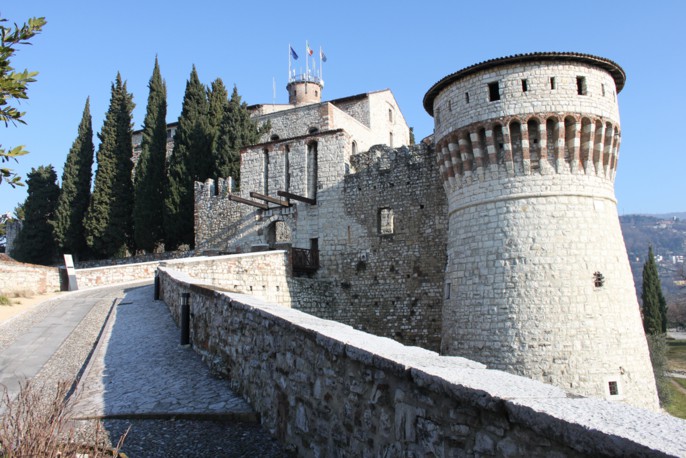
The most distinctive way to reach the Castle is up the cobbled Contrada Sant’Urbano which climbs from piazzetta Tito Speri up the Cidnean Hill.
This short but steep walk, flanked by old houses, takes the visitor in just a few minutes from the city centre to where the first settlers in Brescia built their houses. Surrounded by gardens, the Castle is really a fortified citadel with towers, ramparts, out-houses, courtyards, drawbridges and underground tunnels built between the 13th and 16th centuries. The Mirabella tower was built during the Comunale Period (22 m high) but it was the Visconti family which gave the Castle its current character, erecting 1343 the fortified keep of the Castle right on top of the hill surrounded by a crenellated wall and a deep ditch crossed by drawbridge. Around this central stronghold, the Venetians built bastions, storerooms for provisions (called “Grande e Piccolo Miglio”) and the monumental entrance topped by the St. Mark’s Lion between 1400 and 1500. They also dug out a series of tunnels, some of which can still be walked through.
The Castle, from which there is a magnificent view of the city, houses the Ancient Arms Museum, the Risorgimento Museum, the Cidnean Observatory and, in the storerooms, two large model railways.
The Ancient Arms Museum
The museum is dedicated to Luigi Marzoli who gave his extensive collection to the City Council. It is kept in the most attractive part of the Castle, the 14th century Visconti keep, and is one of the most important collections in Europe. It contains 500 weapons and pieces of armour made in Italy and elsewhere in Europe between 1300 and 1700: helmets, sallets, lances, battle and parade armour, swords, shields and a valuable collection of firearms. These are rare items, masterpieces for their workmanship and the elegance of their decoration. Many were made in Brescia and were early products of the flourishing local arms industry. The museum is also worth a visit for the original 14th century frescoes in many of its rooms, and for the remains of a pre-existing Roman temple which can be seen inside.
The Risorgimento Museum
This museum tells the story of the Italian Risorgimento with particular regard to Brescian history and the episode of the Ten Days in which the city fought heroically against the Austrians who were bombarded in the city actually from the Castle itself. It is housed in the “Grande Miglio” built in 16th century by Venetians.
Photo: Marco Assini
